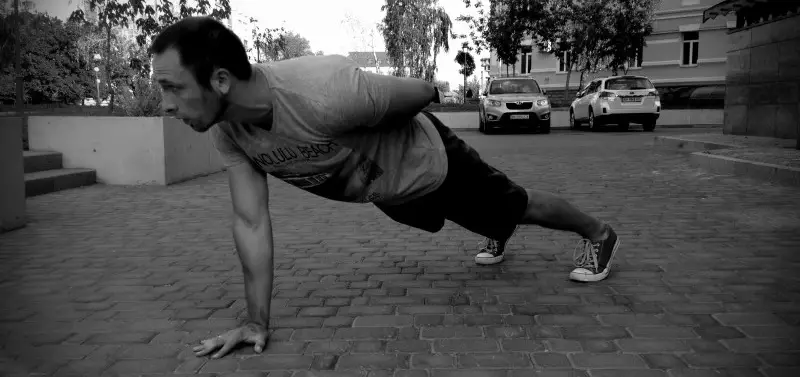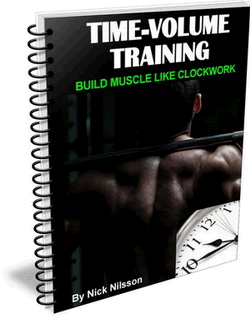By Alex Zinchenko
Author of Rough Strength Files
The Perfect One-Arm Push-Up - many claim to be able to perform it, still there is almost no video proof to back up those claims.
Why so? Firstly, everybody has ego. Claiming that you can do such a complex skill like the Perfect One-Arm Push-Up [POAPU] boosts that ego like nothing else. There is no harm in bragging, unless you cannot back up your words.

Secondly, it is surprisingly easy to get trapped in improper technique with this skill. You can see lots of videos of the One-Arm Push-Up, but 99% of them are half-assed-twisted-body-feet-wide-pseudo-push-ups. That is not what we are discussing here. That exercise has almost nothing in common with real One-Arm Push-Up, and it is a walk in the park compared to our beast.
Many people push this poor technique as POAPU, but do not be fooled. They just do not have the patience to gain the strength required for this move. Thus, they can forget about achieving anything great. Lots of people also do not believe POAPU can be done the proper way, but that is not true. It definitely can be achieved, but the process will require lots of time, hard work, and patience.
Now let us take a closer look to see what the hell the Perfect One-Arm Push-Up is.
What Is a Perfect One-Arm Push-Up?
This question is highly debatable. Everybody has his own criteria for "perfection" of the One-Arm Push-Up. Anyway, I will give you my personal requirements for proper technique. Here is a list:
- The shoulders should be parallel to the ground
- The feet should be not wider than shoulder-width
- The twist of the body should be minimal
- The body should be straight (looking from the side)
- You should lower yourself down until there is no more than 10 cm between the ground and your chest
If you do not meet even just one requirement, then you should reconsider your technique, stop fooling around, and start training the real One-Arm Push-Up.
How Have I Learned About It?
I have learnt about the possibility of the One-Arm Push-Up a long time ago. I was just starting training at that time. I remember exactly the moment when after a set of push-ups my dad came up and asked me: "Can you do it with one arm?" And I was like: "Why not?" Of course, I failed miserably. However, after couple of attempts I figured out that if I spread my legs really wide, twist to the side, and lower only half the way, I can do it. With a feeling of accomplishment, but in reality accomplishing nothing, I happily forgot about the skill for some time.
Many years later I was lucky enough to read one book that changed it all. That was Convict Conditioning. In one of its sections, Paul Wade (author) wrote about the Perfect One-Arm Push-Up. I considered myself pretty strong at that time. "Bench pressing 120 kg for sets of 4, man, I should be able to crush that bodyweight thing" - I believed. Again, I got another reality check and deep understanding and appreciation for heavy calisthenics. From that moment, my fight with POAPU began.
NOTE: Many people call this skill Prisoner Push-Up (popularized after Convict Conditioning). I am OK with it, but will use my term anyway.
What Muscles Does The One-Arm Push-Up Work?
Honestly, I do not questions like these. "Hey, dude, will it work my biceps?" or "What can I do to work my rear delts?" You know what I mean. However, I shall make an exception for this exercise. Why? Because it is quite interesting in this aspect, as well as any high level calisthenics exercise.
The Perfect One-Arm Push-Up is a horizontal push. So we can expect that it works our pecs, front delts and triceps. From experience, I can say that triceps stimulation is the most significant. Second place is shared by the front delts and, wait for it, your lats. How unexpected is that? This happens due to the high demand for body stabilization. Then come your pecs. In the Bench Press, which is also horizontal push, the lats work as stabilizers, but you cannot feel them as much, and so you primarily feel either the pecs, front delts, or triceps.
NOTE: Of course, everything written in previous paragraph is just my experience. You can feel it differently. Who cares, anyway?
Why Train for the One-Arm Push-Up?
Because it is awesome. Not enough? How about insane core and body stability and inhuman pushing strength? Maybe increased arm size as well as hypertrophy in the entire upper body will interest you? What about a stronger grip? Add to the mix the fact that all you need for training is the floor. You can find it everywhere unless you are falling from the sky. So the advantages are obvious for me.
The Main Question
Now just ask yourself this question: "Is it worth the effort?" If you doubt even for a split-second, then forget about it, go play the "Daughters-Mothers" (a popular girls' game here in Ukraine) and call it a day. If your answer is "Hell yes!", then read on.
10 Tips to Master the Perfect One-Arm Push-Up
1. What are the prerequisites?
Or rather, when should you consider starting to learn the POAPU? Well, it is not that easy to answer this question, but let us be reasonable. You should be able to do somewhere around 20+ Diamond Push-Ups, 10+ wall-assisted Handstand Push-Ups, and 3-5 Full ROM wall-assisted Handstand Push-Ups. Then you can start, but you need to progress…
2. Slow and steady.
I cannot emphasize this enough. You can learn the POAPU only very slowly due to the highly demanding nature of this skill. Let me give you an example. I was talking with one highly known Ukrainian powerlifter one day. I mentioned the POAPU in conversation. He said: "Hey, I can try it". Here are couple of details:
- He had a body weight of 93 kg at that time
- He bench pressed raw 170 kg for double couple of days ago and I was spotting him (so he's pretty strong)
I explained him all the technique points and he got into POAPU starting position. He tried to do the repetition and after heavy struggle, he finally has got one very shaky ugly rep. Why am I telling this? Yes, he had no skill in this move, he tried it for the first time and in couple of weeks/months he could do an easy 5. However, the main point is that even a high-level powerlifter (that can bench press 2 times his bodyweight, raw and for reps) struggled big time with this move. So if you are not in that category, I advise you to start as slow and light as possible.
3. Always shift your weight to the working arm.
Sounds simple, but, then again it is very easy to get carried away and end up with poor technique and no strength. Lots of progression exercises will involve two arm work. One arm will be as close to the POAPU position as possible, and will be doing all the work. The second one will be assisting. This type of progression will work only on one condition: your working arm should do the majority of work and the assisting arm should only assist. Otherwise, you will fail.
4. Vary the progressions.
I have noticed that with the POAPU the issue of training variety is critically important. Oftentimes increasing strength with one type of progression becomes really hard very soon. So it is wise to vary them or to use several in one training cycle. What progressions to use?
5. Here are some example progressions.
There are two main issues in learning the POAPU: front delt/triceps/lat/pec strength and core strength. The latter can be trained by simply holding the proper top position of the Perfect One-Arm Push-Up and it is rarely an issue. It is the easier of the two. The delt/triceps/lat/pec strength requires a progressive approach where we use the resistance from the easiest to hardest until we can do a push-up solely with one arm.
I can divide the learning approaches into three:
- The one with changing the body's position in space
- The one with the assisting arm
- Others
The one with changing the body position in space. This is simple. If you cannot perform the POAPU on the floor, use the surface that is higher. For example, a couch, table, or even a wall. Find the one that is suitable for your current levels of strength and start from there.

The one with an assisting arm. You will be in actual POAPU position and will assist with your non-working arm. Again, there are several ways to do it. I can think of four reasonable ones.
The first way is finger assisted. You get into the POAPU position and place the fingertips of your assisting hand close to you. When you get stronger just use less and less fingers, like 5, 4, 3 etc.

The second way is towel assisted. Get into the POAPU position on a slick surface. Put a towel near you and place your assisting hand on it. As you lower down you just slide the towel forward and when you push up - slide it back. The main point here is to hold your assisting arm locked in the elbow throughout the whole movement.


The third way is a mix of both the finger and towel assisted versions. The same as the second, but instead of your whole hand, you put only fingertips on the towel.
The fourth way is to hold onto a gymnastic ring with your assisting arm at shoulder height. As you lower down just slide the ring to the side. It is similar to the towel assisted version, but feels a bit different. Again, the elbow of your assisting arm should be locked throughout the whole move.
The others (my classification is awesome as always).
In this category, you can put any other reasonable progression. For example, a band assisted version. Put the resistance band under your chest. As you lower down, it will support you and decrease the resistance.
[Editors Note: This is my recommended source for training bands. Use Coupon Code "rbtfitstep" to get 10% off your purchase of a band package]
Another choice would be leg progression. If you can do POAPU with your feet wide, you can progress through decreasing the feet width.
And, of course, do not forget the partials. Put some books under your chest to decrease the range of motion. Once you get stronger, just take out one book and start over.
I think I gave enough progressions to keep you busy for some time.
6. You need to follow a set/rep prescription for strength.
3 sets of 5, 5 sets of 3, 4 times 4, 4 sets of 2, 6 sets of 1 etc. There are lots of reasonable schemes. In addition, you can use a more flexible scheme of total reps (described earlier in the book). For example, perform a total of 15 reps in 5 repetition maximum exercise. So your session can look something like this:
Set 1: 4 reps (I prefer to leave one in the tank)
Set 2: 4 reps
Set 3: 3 reps (things get harder)
Set 4: 2 reps
Set 5: 2 reps.
Total: 15 reps.
7. How often?
This is another tricky question. Everybody is different, so you will need to experiment to determine the frequency that works for you. Start training it once per week. Do it for 4-6 weeks. Then try twice per week. Stick to this frequency for 4-6 weeks. Then compare the results. Pick the one that turned out to be the best. You may also experiment with 3 times per week, but in this case, you will need to balance intensity and cut the volume.
8. How to include the POAPU work into a program?
Do you remember the "What Muscles…" section? The POAPU is a horizontal push. Here is a couple of thoughts on programming:
- If you want to get good at it, you need to put it first.
- You can alternate POAPU work with One-Arm Chin-Up work.
- Basically, you can switch any horizontal push exercise for POAPU work.
- If you train POAPU once per week, it is reasonable to stick to one progression for 4-6 weeks.
- If you train POAPU twice or 3 times per week, it is good to use different progressions on different days.
9. When to progress?
A good rule of right time for making it to the next step I learnt from Mike Mahler. When you can do 2 reps more than you need on the last set, it is time to go further. If you need to do 3 sets of 5 and you can do 7 reps in the last set, add resistance for the next session.
10. What is next?
So we will assume that you have mastered the Perfect One-Arm Push-Up. How can you progress further? Several ways come to my mind:
- Add weight. Straight and simple. You can use a weighted vest, chains, bands or a backpack.
- Elevate your feet. This will definitely make the POAPU harder. Work your way up until you end with OAHSPU.
- Try the fingertip version. You will gain incredible strength in your fingers. If you are brave enough, you can work up to Claw Fingertip Perfect One-Arm Push-Ups (more on this later in this section).
- Mix of the above. Screw it all and try the Weighted Feet-Elevated Claw Fingertip Perfect One-Arm Push-Up (notice how good I am in creating pointless long names for exercises)
Is It Reasonable to Use Weights to Learn the POAPU?
Nothing will be better in learning the POAPU than actual practice of the skill. With this in mind you can try to add assistance exercises with weights. However, it all depends on the individual. Some will benefit, while others will see no difference.
Try adding One-Arm Kettlebell Floor Presses, or use a dumbbell if you like. In addition, Military Presses will not be a waste of time.
Closing Thoughts
What can I say in conclusion? The Perfect One-Arm Push-Up is the skill that requires lots of patience and hard work. Not everybody will be dedicated and disciplined enough to earn this skill. However, those who will still manage to push through all the obstacles will acquire the skill that very tiny amount of the Earth population has. Then comes the bragging part. Nevertheless, remember, you cannot brag unless you grow a beard or at least mustache. That is it.
Play rough!
Alex Zinchenko
Alex Zinchenko is a strength addict, coach and author of the Rough Strength blog, where he shares his crazy ideas regarding training and nutrition. He is honest to toothache, straightforward like a train, and too daring to believe that heavy calisthenics, kettlebell and sandbag training along with intermittent fasting can deliver all the results you want.
You can check out his book "Rough Strength Files" here.
![]()
More From Fitstep.com
Share This Page...
---
Home -> Muscle and Strength -> Tips and Articles -> One-Arm Push-Ups




